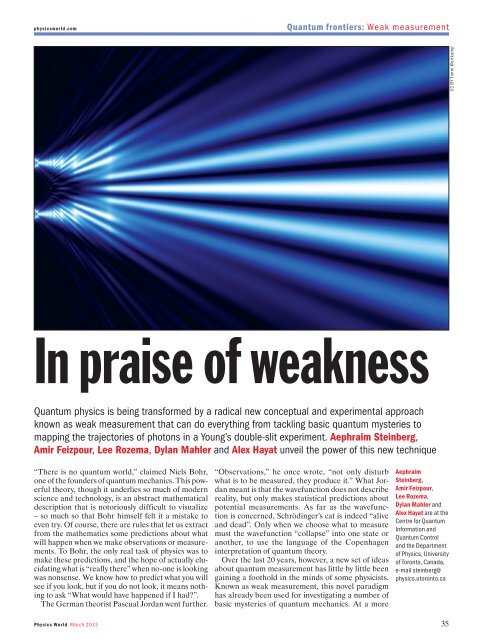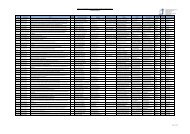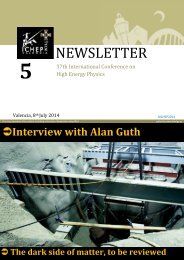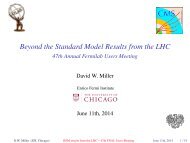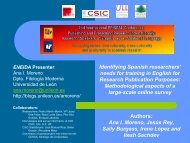PW_mar13_sample_issue
PW_mar13_sample_issue
PW_mar13_sample_issue
Create successful ePaper yourself
Turn your PDF publications into a flip-book with our unique Google optimized e-Paper software.
physicsworld.com<br />
Quantum frontiers: Weak measurement<br />
In praise of weakness<br />
Quantum physics is being transformed by a radical new conceptual and experimental approach<br />
known as weak measurement that can do everything from tackling basic quantum mysteries to<br />
mapping the trajectories of photons in a Young’s double-slit experiment. Aephraim Steinberg,<br />
Amir Feizpour, Lee Rozema, Dylan Mahler and Alex Hayat unveil the power of this new technique<br />
“There is no quantum world,” claimed Niels Bohr,<br />
one of the founders of quantum mechanics. This powerful<br />
theory, though it underlies so much of modern<br />
science and technology, is an abstract mathematical<br />
description that is notoriously difficult to visualize<br />
– so much so that Bohr himself felt it a mistake to<br />
even try. Of course, there are rules that let us extract<br />
from the mathematics some predictions about what<br />
will happen when we make observations or measurements.<br />
To Bohr, the only real task of physics was to<br />
make these predictions, and the hope of actually elucidating<br />
what is “really there” when no-one is looking<br />
was nonsense. We know how to predict what you will<br />
see if you look, but if you do not look, it means nothing<br />
to ask “What would have happened if I had?”.<br />
The German theorist Pascual Jordan went further.<br />
“Observations,” he once wrote, “not only disturb<br />
what is to be measured, they produce it.” What Jordan<br />
meant is that the wavefunction does not describe<br />
reality, but only makes statistical predictions about<br />
potential measurements. As far as the wavefunction<br />
is concerned, Schrödinger’s cat is indeed “alive<br />
and dead”. Only when we choose what to measure<br />
must the wavefunction “collapse” into one state or<br />
another, to use the language of the Copenhagen<br />
interpretation of quantum theory.<br />
Over the last 20 years, however, a new set of ideas<br />
about quantum measurement has little by little been<br />
gaining a foothold in the minds of some physicists.<br />
Known as weak measurement, this novel paradigm<br />
has already been used for investigating a number of<br />
basic mysteries of quantum mechanics. At a more<br />
Aephraim<br />
Steinberg,<br />
Amir Feizpour,<br />
Lee Rozema,<br />
Dylan Mahler and<br />
Alex Hayat are at the<br />
Centre for Quantum<br />
Information and<br />
Quantum Control<br />
and the Department<br />
of Physics, University<br />
of Toronto, Canada,<br />
e-mail steinberg@<br />
physics.utoronto.ca<br />
Physics World March 2013 35<br />
CC BY Timm Weitkamp


